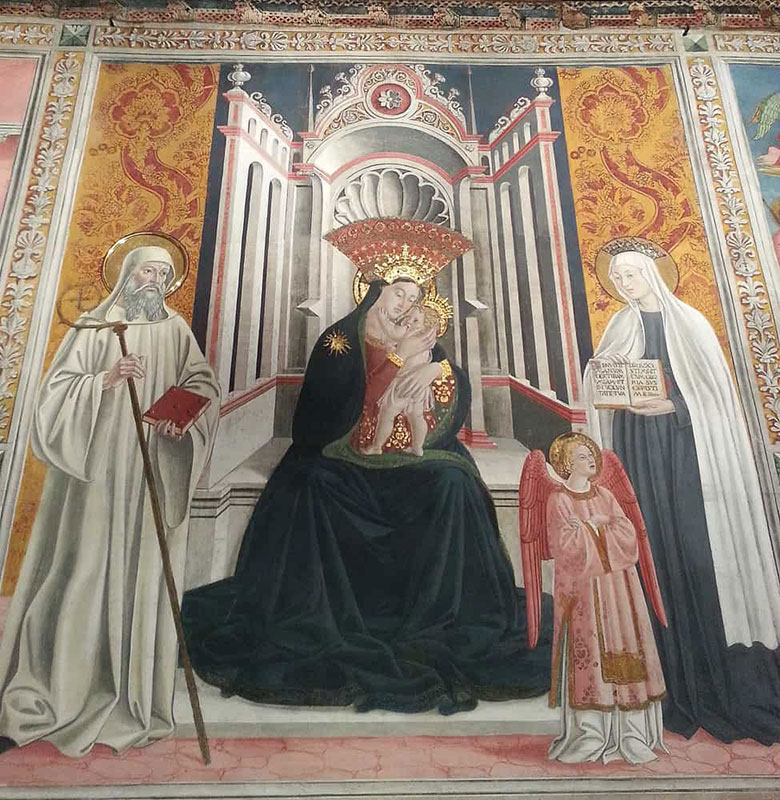9 March, Saint Frances of Rome, Advocata Urbis

Patron Saint of motorists
Francesca Bussa in Ponziani was known to people as “Ceccolella”. She was born into a noble family and was recognized for her charity and for her lack of shame in begging for alms for the poor.
Born in Rome in 1384 to Paolo Bussa di Leoni and Giacobella di Roffredeschi, she loved to read the biographies of the saints as a young child, and was attracted to spiritual matters. Her spiritual guide was Fr. Antonio di Monte Savello, an Olivetan Benedictine who served at the Church of Santa Maria Nuova al Foro. She wished to consecrate herself to God, but by the time she was 12, her father had already made plans to marry her off to Lorenzo Ponziani, who hailed from a very wealthy family.
Once she was married, Frances dedicated herself to domestic duties in her husband’s palace in Rome’s Trastevere neighbourhood, near the Basilica of Saint Cecilia. She continued to lead a pious life of penance and went to Confession once a week. She often went on pilgrimages to Rome’s Basilicas with Vannozza, the wife of her husband’s older brother, who became her companion in the faith.
Despite her social standing, Frances’ life was marked by suffering and family tragedies. Two of her children died young, during an epidemic. Between 1408 and 1414, when Naples occupied Rome, the Ponziani family, who was loyal to the Church and to the Orsini, and against King Ladislaus of Anjou-Durazzo and the Colonna, was subjected to reprisals and acts of vengeance. Frances’ husband was seriously wounded, an injury that affected him for the rest of his life. Her brother in law, Paluzzo, was exiled and her son Battista, who was still a child, was taken hostage. The palace was ransacked and the family’s possessions were confiscated. They were later returned.
Frances continued her charitable work, offering aid despite the difficulties, and supporting the poor and the sick in the following hospitals: S. Maria in Cappella, S. Cecilia and S. Spirito in Sassia. She opened her palace to those in need and those who turned to her for help. During periods of famine, she emptied her granary and cellars to feed the hungry. Even though she was the wife of a wealthy nobleman, she gave up the typical ornaments of women of her class, choosing instead, a simple and modest attire. She sold her expensive dresses and used the money to sew clothing for the poor.
She was considered a miracle worker, who was capable of healing illnesses of the body and of the soul. Sometime around 1425, Lorenzo accepted Frances’ request to live a marriage of chastity. From that time onwards, she began to experience several episodes of ecstasy and visions. She became the guide of a group of companions, who later went on to live together as a community.
On 15 August 1425, Frances and nine companions made their monastic oblation with the formula of the Benedictine Olivetans, in the Basilica of Santa Maria Nova al Foro. For a few years, the oblates lived in their own homes. In 1433, they purchased a house in Tor de’ Specchi, on the western side of the Campidoglio and began their lives as a community. Meanwhile, Frances continued to nurse her husband, until his death in 1436. Freed from her bond of marriage, she joined her companions and became their guide. She lived with them for four years and died on 9 March at Ponziani palace, as she recited the Office of the Blessed Virgin Mary, to whom she had always been devoted.
The entire city mourned her death. The Roman Senate unanimously voted to grant her the title, “Romana”, and she was proclaimed Advocata Urbis. In 1925, Pius XI proclaimed her Patron Saint of motorists. According to tradition, Frances could see her guardian angel protecting her from danger by radiating light, as she walked through Rome at night.





